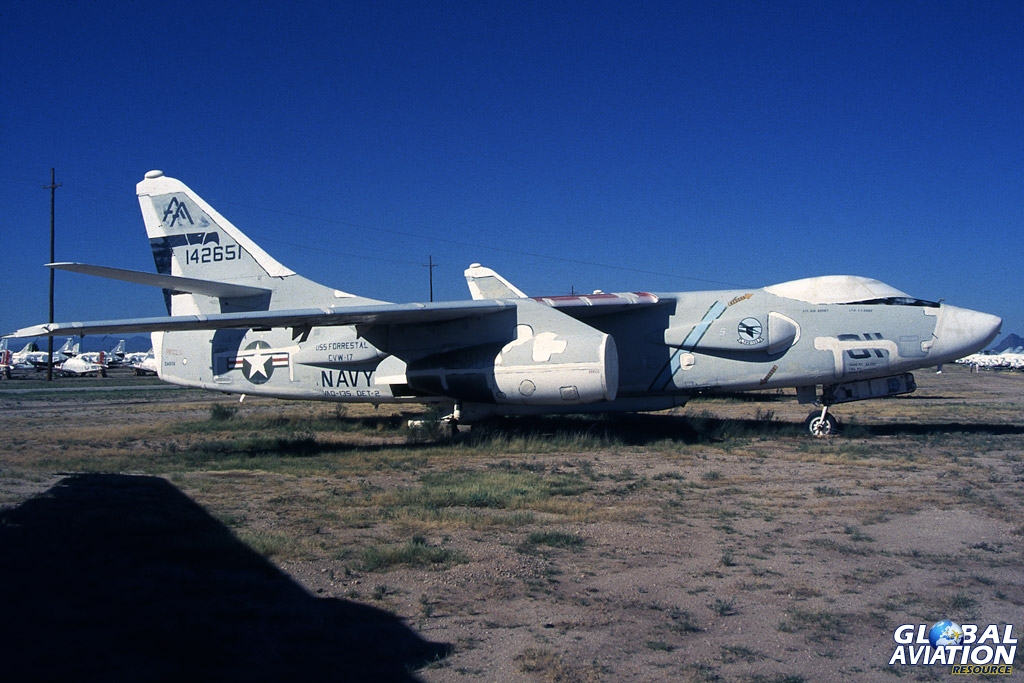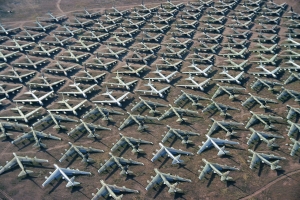The 309th Aerospace Maintenance and Regeneration Group (AMARG) on the outskirts of Tucson, Arizona has always been a Mecca for aviation enthusiasts and historians, with its living history of thousands of stored aircraft from all branches of the Department of Defense. Kev Jackson writes for GAR.

The 1980s saw many ANG/AFRES, USN and USMC Phantoms retired as the F-16s and F/A-18s began to replace them, including this MiG killer Oregon ANG F-4C photographed in 1987, that also once saw service at RAF Bentwaters in the UK. © Kevin Jackson – globalaviationresource.com

This famous record breaking F-106, formally with the NJ ANG was converted to a QF-106 at Tyndall AFB but survives intact to this day. (1987) © Kevin Jackson – globalaviationresource.com

This US Navy DC-130A sits on its tail in 1987. © Kevin Jackson – globalaviationresource.com
My first encounter with the ‘Boneyard’ was during my first trip to the USA in February 1987. As a kid with a big interest in military aviation it was always a dream to visit AMARC (Aerospace Maintenance and Regeneration Center), as it was known back then. The place never disappointed, with the sheer size of the storage areas almost overwhelming, containing aircraft types I had only ever seen in films, photographs and books. I returned in October 1989 and once again took advantage of the Saturday tour the USAF then operated that allowed us to disembark the bus at regular intervals and wander some of the rows of stored F-4s, C-130s, P-3s, century series fighters rarely seen in Europe, or B-52s, feverishly taking as many photos as possible with my limited supply of Kodachrome 64 transparency film; oh, for a time machine to return with today’s digital equipment!

A row of B-52D models dwarfs a lone visitor in February 1987. © Kevin Jackson – globalaviationresource.com

Douglas EKA-3B Skywarrior (BuNo 142651) of VAQ-135 Det.2 assigned to Carrier Air Wing 17 (CVW-17) aboard the aircraft carrier USS Forrestal (CVA-59) was retired to AMARC (then MASDC) in 1973. (1987) © Kevin Jackson – globalaviationresource.com

BUFFs as far as the eye can see back in 1987. Nearly 400 were retired to MASDC/AMARC in the 80s/90s. © Kevin Jackson – globalaviationresource.com
I managed to get back over to Arizona for my third visit in late September 1992 during a mega three-week, 7,000 mile aviation road trip with three other mates. On this occasion we took the opportunity to view the ‘Boneyard’ from the air for the first time, courtesy of Double Eagle Aviation located at nearby Tucson Airport and their experienced AMARC overflight tour pilots. Criss-crossing the storage areas on a Sunday afternoon in a Cessna 172 for an hour really gave us a true perspective of the scale of the operation. 1992 probably marked the busiest period in the history of the ‘Boneyard’, with a huge amount of aircraft being retired as the end of the Cold War “peace dividend” took effect. At the time of our visit there were on average 20 aircraft arriving for storage per day. The arrivals ramps were full and many aircraft were taken straight to the storage areas immediately following the draining of fuel, as there simply wasn’t the manpower to fully protect all the arrivals with Spraylat immediately.

The great view from a large mound of earth next to Kolb Road in 1992, unfortunately now flattened. © Kevin Jackson – globalaviationresource.com

74-1874 is one of two Boeing YC-14A demonstration aircraft, entered in competition with the MDD YC-15A for the C-130 replacement tender. © Kevin Jackson – globalaviationresource.com

A Desert Storm veteran B-52G (note mission markings) makes its last ever journey across the bridge over Kolb Road in 1992, to be broken up. © Kevin Jackson – globalaviationresource.com
At its height in 1992-1995, AMARC were storing/processing over 5,000 aircraft. With the destruction of around 370 B-52s under the START 1 treaty in the 1990s and hundreds of other aircraft in storage since the 1970s and ’80s reduced to parts and scrapped by the surrounding yards, the headline numbers have reduced.

An overview of a large section of AMARC in 1992. © Kevin Jackson – globalaviationresource.com

In the mid-1990s hundreds of B-52s dominated AMARC, now most have been reduced to ingots. © Kevin Jackson – globalaviationresource.com

KC-135As sit with a few “white Top” EC-135As in 1992. © Kevin Jackson – globalaviationresource.com
However, there is still a steady stream of aircraft such as older C-130s, C-5s, P-3s, F-15s and F-16s that continue to arrive as budgets get squeezed and squadrons are disbanded or convert to UAVs, keeping the base’s 700-strong workforce as busy as ever.

A mass of A-7 Corsair IIs as seen in 1995. © Kevin Jackson – globalaviationresource.com

This 1995 aerial view shows many F-16A/Bs, Seasprite helicopters and S-3B Vikings in storage. © Kevin Jackson – globalaviationresource.com

To the east of Kold Road, the RIT (Reclamation Insurance Type) area is where airframes are stripped for spares. As seen in late 1995. © Kevin Jackson – globalaviationresource.com
In October 1995 I returned once more to take another overflight, as the storage areas were now at their peak. Sadly, the Air Force-run bus tours that let the public off to roam freely had ended by then and the responsibility for tours transferred to the excellent Pima Air Museum. These tours continue to this day and are very popular; however, you can no longer disembark the bus. It was to be 12 years until I next had access to AMARG via their Public Affairs office. I will share those images in part 2.
In this first of a two-part look at AMARG I wanted to share my slides from those first four visits between 1987-1995, to hopefully give you a sense of how ‘fluid’ the storage facility is and how different it looks from today. Part two will take a look at more recent views of the famous ‘Boneyard’ in 2007.
















The B-52 being towed across the bridge was assigned to the 379th Bomb Wing/524th Bomb Squadron at Wurtsmith AFB, MI. The planes assigned there used the “Delta K” tail flash in honor of their predecessor, the 379th Bomb Group/8th AF, which flew B-17s from RAF Kimbolton. Most of the planes there were Desert Storm vets, some of them launching from Wurtsmith the night the war started, flying their missions, then recovering at various bases (Jeddah Saudi Arabia, Diego Garcia, and RAF Fairford). Looking at the amount of mission symbols, this ship was most likely called “Old Crow Express,” which flew the most missions of any 379th ship during DS, and was the last B-52 to leave Wurtsmith.